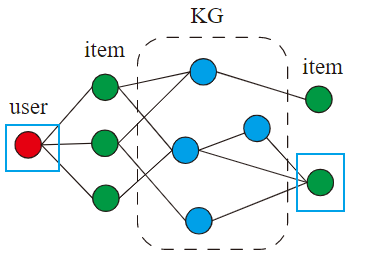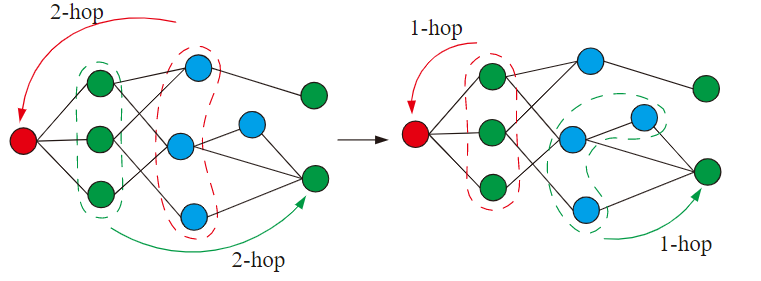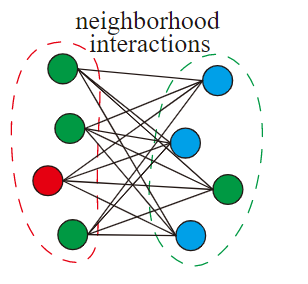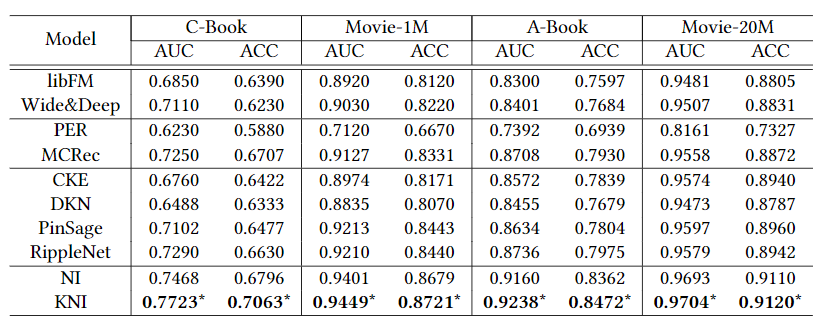(KNI)An End-to-End Neighborhood-based Interaction Model for Knowledge-enhanced Recommendation 论文笔记
KNI: An End-to-End Neighborhood-based Interaction Model for Knowledge-enhanced Recommendation
创新点
针对之前的模型,我们提出了其存在的early summarization problem,针对这一问题,我们采用Neighborhood Interaction (NI) model,相比较早期仅仅只用item的向量和user的向量计算点积率。我们这里使用item的neighborhood和user的neighborhood进行计算,可以捕捉珍贵和复杂的结构信息
“early summarization”:仅将user/item自身及周围的邻居信息全部汇聚到一个向量,这种方式的缺点是没有利用到item/user的local structures,即item neighborhoods与user neighborhoods之间的联系没有捕捉到。只捕捉到了目标item与user之间这一条边的关系
为了进一步丰富节点间的连接信息和高阶结构化信息,我们引入了知识图谱,用来增加节点间的连接。因此我们称这种方法为KNI
模型
NI模型
计算user对于item期望值的模型
\[ \begin{aligned} \text { Attention: } \hat{y}_{u, v} &=\left\langle\sum_{i \in N_{u}} \alpha_{u, i} \mathbf{x}_{i}, \sum_{j \in N_{v}} \alpha_{v, j} \mathbf{x}_{j}\right\rangle \\ &=\sum_{i \in N_{u}} \sum_{j \in N_{v}} \alpha_{u, i} \alpha_{v, j}\left\langle\mathbf{x}_{i}, \mathbf{x}_{j}\right\rangle \end{aligned} \]
其中\(N_{u}\)为user的neighborhoods,\(N_{\mathcal{V}}\)为item的neighborhoods。简写如下:
\[ \hat{y}=\mathrm{~A} \odot \mathrm{Z} \]
其中:
\[ \sum_{i, j} \mathrm{~A}_{i, j}=1, \mathrm{Z}_{i, j}=\left\langle\mathrm{x}_{i}, \mathrm{x}_{j}\right\rangle \]
对于其中权重的计算,论文中提出如下bi-attention network:
\[ \alpha_{i, j}=\operatorname{softmax}_{i, j}\left(\mathbf{w}^{\top}\left[\mathbf{x}_{u}, \mathbf{x}_{i}, \mathbf{x}_{v}, \mathbf{x}_{j}\right]+b\right) \]
node embedding模型
通过GCN,GAT来学到对于user/item的embedding,用学得的embedding来替代NI模型中的\(\mathbf{X}_{i}, \mathbf{X}_{j}\)
假设当前计算的是node u的表示,则i是所有与u在one-hop之内相连的节点,最外层的节点\(\mathbf{X}_{j}\)用初始向量进行计算,讲过一次卷积得到node i的表示
\[ \mathbf{x}_{i}^{1}=\sigma\left(\frac{1}{\left|N_{i}\right|} \sum_{j \in N_{i}} \mathbf{w}^{1} \mathbf{x}_{j}+\mathbf{b}^{1}\right) \] 将node i的表示带入node u的卷积计算中,得到node u的表示
\[ \mathbf{x}_{u}^{2}=\sigma\left(\frac{1}{\left|N_{u}\right|} \sum_{i \in N_{u}} \mathbf{w}^{2} \mathbf{x}_{i}^{1}+\mathbf{b}^{2}\right) \]
引入知识图谱的NI模型
即KNI模型

在user和item之间加入KG的entity来扩充图中的关系和实体
整体计算流程
通过GNN逐层传递周围2-hop内的信息到目标节点,计算两个节点的embedding

通过计算到的embedding,计算目标节点的neighborhood之间的期望得分

实验结果

实验证明NI模型的计算是有用的
反思
- 将user-item之间的交互转化为neighbor-neighbor之间的交互,摆脱了双塔模型,相当于基于图的计算
(KNI)An End-to-End Neighborhood-based Interaction Model for Knowledge-enhanced Recommendation 论文笔记